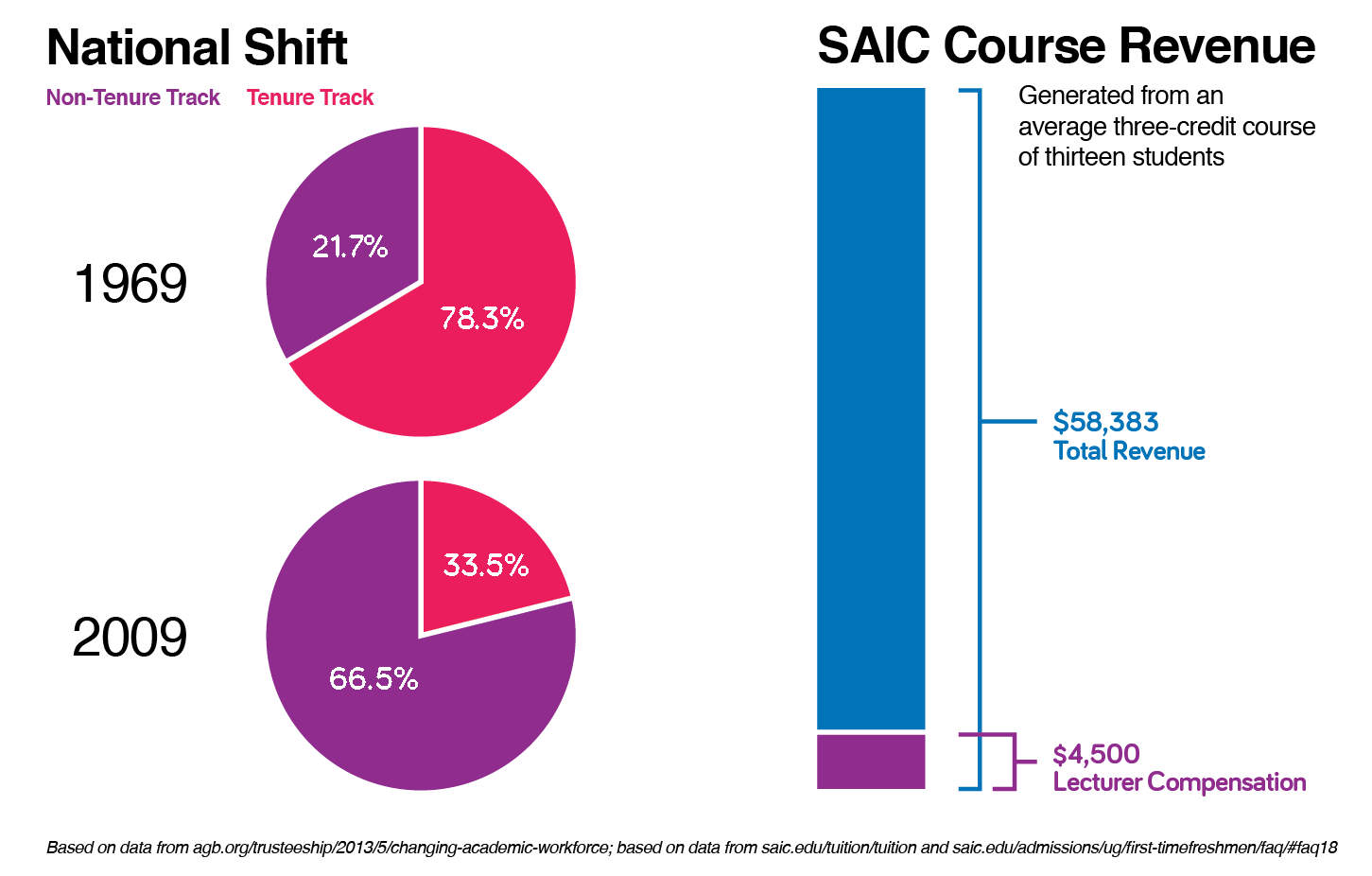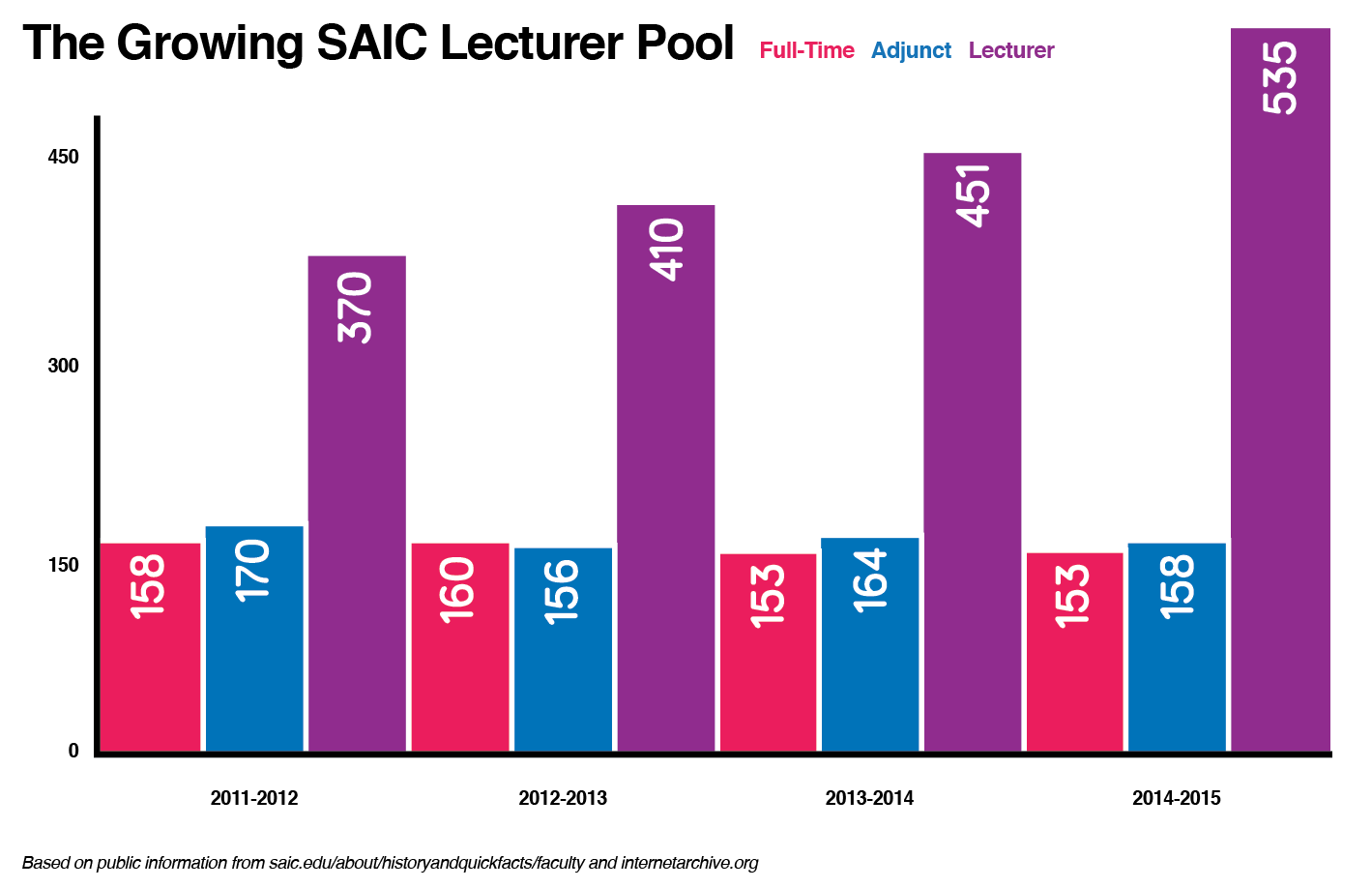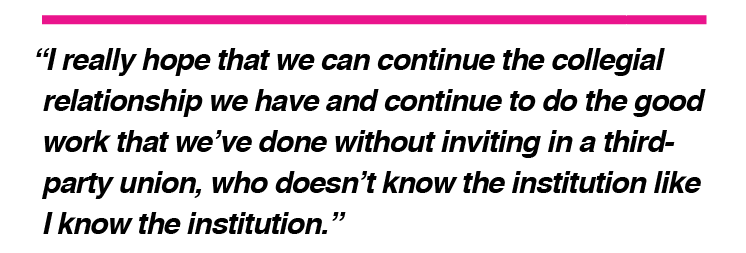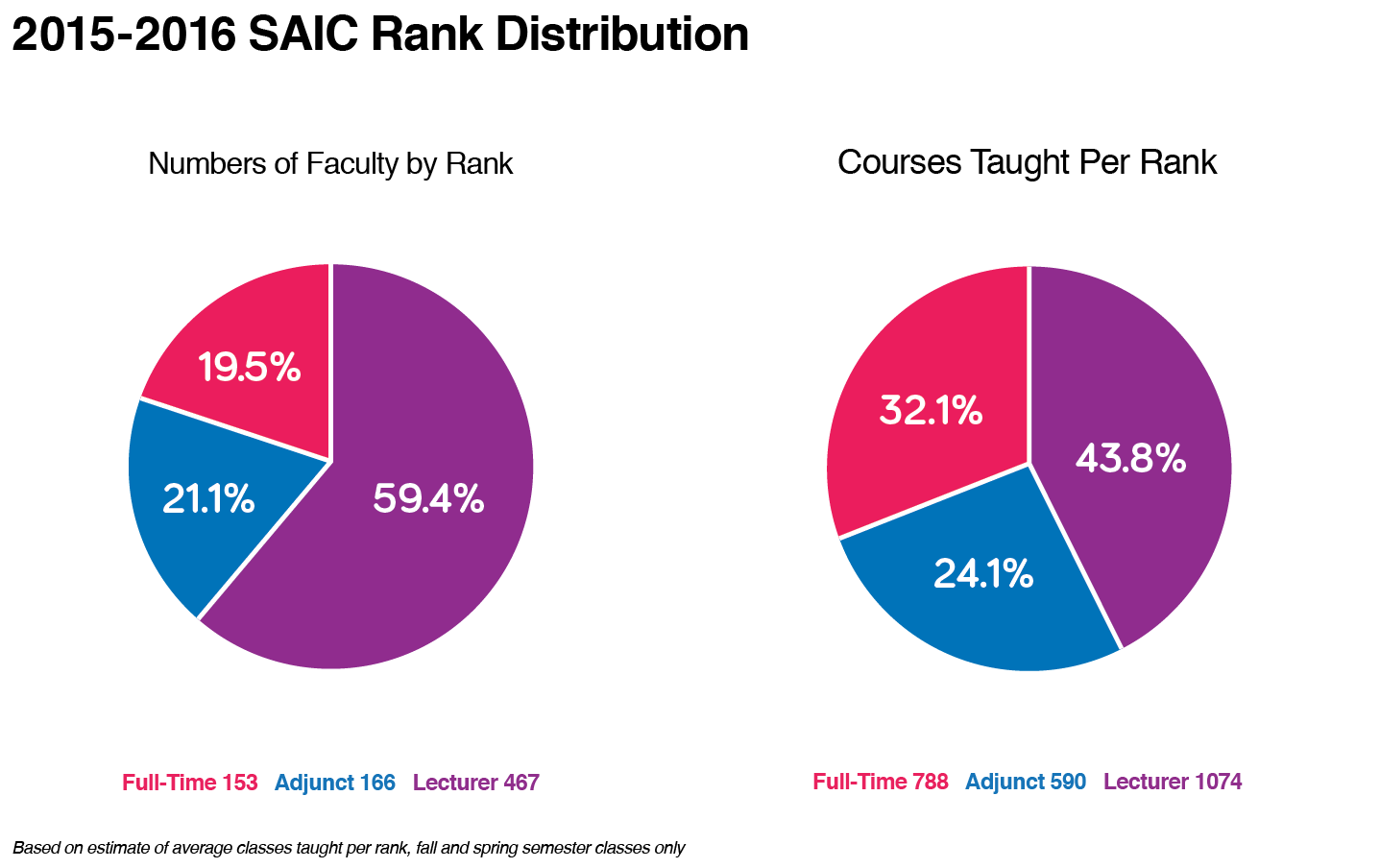Update April 28: Since this article was initially published online SAIC’s administration has created a new website responding to the two organizing efforts on campus by SEIU and UAC through their parent organization, AFT. The homepage reads:
“We recently learned that part-time faculty members at the School of the Art Institute of Chicago are being targeted for unionization. This website provides background information about unions and the unionization process. It also provides an overview of how SAIC has historically collaborated directly with part-time faculty to enhance compensation and benefits, and expand professional opportunities.”
The site includes a letter from Elissa Tenny, Provost and Senior Vice President of Academic Affairs and Wainwright highlighting SAIC’s “longstanding commitment” to the part-time faculty and the history of collaborating with the Faculty Senate and Part-Time Concerns Committee. The letter details a number of incentives including promotions, an accelerated compensation plan to increase the minimum per-course rate, the implementation of a course cancellation fee of $500 if a part-time faculty member has a course canceled. Some of these initiatives were previously spelled out in a letter sent to all part-time faculty from Wainwright and Tenny in mid-April.
The website’s letter highlights the “time-consuming” and “complex set of legal rules and requirements” of unions. The site is presented as resources meant to clarify confusion about the process about joining unions — including fact sheets on AFT and SEIU — the two unions currently vying to represent part-time faculty. However, many of the resources include language restating the official administration position. There is also a contact form on the site in which part-time faculty can submit questions they have, after they have entered their name and email address.
We will be updating this story as more details emerge.
Two union groups — Faculty Forward (a part of the Service Employees International Union, or SEIU) and the United Academics of Chicago (UAC) — are currently vying for support amongst adjuncts and lecturers at the School of the Art Institute of Chicago (SAIC). Part-time faculty have raised a number of issues, ranging from pay discrepancies to the ability to negotiate multi-year contracts, to establishing a more transparent hiring process.
According to Jeremiah Hulsebos-Spofford, a lecturer in the Contemporary Practices department, members of SAIC faculty have been attending citywide meetings with Faculty Forward since fall 2015. Hulsebos-Spofford was attracted to Faculty Forward in part because his wife, a faculty member at the University of Chicago, participated in organizing efforts on that campus, and the organization has a track record of successes.
“[Faculty Forward has] helped organize a number of art schools, and I think SAIC, being an art school — that’s a huge consideration in regards to the finances and culture of the school. Recently, the San Francisco Art Institute, MICA, and a number of other art schools with contingent faculty affiliated with SEIU Faculty Forward and won their elections, and have been negotiating contracts with their schools,” Hulsebos-Spofford said.
Monica Ryan, a lecturer in the Sound department, said that a group of part-time faculty started a research group over a year ago. Ryan was among those who reached out to UAC to the Illinois Federation of Teachers (IFT), another local offshoot of the parent organization, the American Federation of Teachers (AFT).
Hulsebos-Spofford and Ryan both initially started working with IFT in April. Hulsebos-Spofford later joined organizing efforts with Faculty Forward. But through Ryan’s inquiries, UAC was the first to begin organizing efforts on campus in August of last year, shortly before SEIU Faculty Forward also arrived.
Who is involved?
UAC, a part of AFT, is a Chicago-based union only for adjuncts. They are currently working with faculty at SAIC as well as DePaul, St. Augustine, and Northwestern, in an effort to raise general standards around labor at universities.
AFT is the largest higher education union in the country, representing over 230,000 higher education faculty, staff, and graduate student employees. It is also the largest adjunct union. In Chicago alone, there are over 5,000 higher education members of AFT.
Faculty Forward is a citywide part of SEIU, a union primarily focused on labor issues in the service sector. In the past three, SEIU has increased its involvement in issues among part-time faculty on college campuses. Faculty at Tufts, American University, Georgetown, and George Washington University have voted to unionize, with the support of SEIU’s Adjunct Action campaign.
The Chicago Tribune reported on SEIU’s efforts at the University of Chicago in December 2015, explaining, “While other Chicago-area universities have faculty unions, the University of Chicago is the first local election spurred by SEIU’s Faculty Forward campaign, which in the last three years has helped formed 30 unions of nontenured faculty across the U.S.”
An important distinction between UAC and SEIU Faculty Forward is that if faculty choose to join SEIU Faculty Forward, they will be part of SEIU Local 73, which has almost 30,000 members and only a small portion includes part-time faculty and nontenured full-time faculty. If faculty decide to join UAC, their union local would only include part-time faculty and nontenured full-time faculty at SAIC.
What are the issues?
The presence of two unions on the SAIC campus has created a competitive environment. And there are real differences in strategies for both organizations.
“I don’t want to speak to SEIU,” Ryan said. “I can definitely name what I liked about UAC and AFT. It’s not a third party. The union is us. We wouldn’t be joining someone else’s local. We would be our own thing, making our own decision, deciding what our own issues are. And then we would be doing that in support of the other people around … This is a very different fight than just simply pay equity. I respect what SEIU does in terms of unionizing service workers — the people who go up against some pretty nasty folks. But I think that’s not our situation,” she continued.
On April 7, SAIC faculty already part of the SEIU Faculty Forward campaign sent a letter to all part-time faculty that cited many successes of previous SEIU efforts, in a call for others to sign the authorization card. The letter read, in part:
• At Tufts University, part-time lecturer pay per course will go up 22 to 40 percent over the next three years, with a floor of $7,300 per course by September 2016
• California State University lecturers receive general salary increases at
the same percentage level as tenure-track faculty• If they teach 40 percent of full-time, lecturers in the California State University system qualify for the same subsidized medical, dental, optical, life and disability insurance as tenure-line faculty
• Tufts University part-time lecturers with four years of service are eligible for two-year appointments, and those with more than eight are eligible for three-year appointments
• Tufts University faculty and administrators are working on a revamped evaluation process that will be used to improve performance rather than solely for discipline
• University of Chicago and Loyola full time and part time faculty won their union elections and formed their bargaining committees to begin working towards strong first contracts
A petition from AFT/UAC and AFT has been passed to faculty as well. The AFT/UAC strategy is to work within the part-time representative system and mobilize around successes before unionization occurs. The petition reads:
We the contingent faculty at SAIC are united in calling on the administration to create multi-year contract provisions which include:
• three-year contracts for adjuncts
• two-year contracts for lecturers
• course guarantees during the life of multi-year contracts
• clear renewal and non-renewal policies and processes
Why a union?
Faculty have named a number of reasons for wanting to join a union. David Mihalyfy, a lecturer in the Liberal Arts Department, said, “I think the main thing to keep in mind with unionization
is that this is about acquisition of a set of privileges.”
In addition to issues of pay, Mihalyfy expressed an interest in access to more faculty training and said that a union would allow for negotiating a bundle of many separate privileges simultaneously.
“A bunch of us have been just dying to have better ESL training so we could better help students where English is not their native language,” Mihalyfy said.
Hulsebos-Spofford echoed the sentiment, saying the current part-time representative system allows the administration to pick and choose which concerns they will prioritize.
Ryan spoke about not being able to have access to disability accommodations as part-time faculty members. Ryan, who has dyslexia, said she applied to get a Writing Fellow in 2014 — a graduate student peer mentor who normally assists students with their writing. “Because of my disability I was basically asking if there was some way I could have a grad student just read over my materials,” she said.
Ryan said the department head of Sound: Art and Technologies assisted her in putting in a request over the winter break. “When no help was offered, Shawn [Decker] cleared a TA to work with everyone teaching Intro to Sound. So Shawn got around the impasse by [offering] not an accommodation for me, but a TA for everyone,” she said.
According to Valerie St. Germain, the director of the Disability and Learning Resource Center at SAIC, all disability accommodations for faculty must be handled through the Human Resources department. The on-campus disability resource center does not assist faculty.
When asked if she felt this lack of accommodation has affected her classes, Ryan said she feels as though her classes have suffered. Ryan believes a union would allow for recourse for issues like hers and to bargain for accommodations. (At the time this article went to press, Ryan said she was in meetings with someone in the Dean’s office to talk about an accommodation.)
Brian Sikes, current Chair of Contemporary Practices, gave some insight into organizing efforts put forth by part-time faculty in the 1990s. According to Sikes, the priority wasn’t necessarily to form a union but to have certain demands met — although unionizing was always an option on the table.
He added, “When we got together, we made it very clear we wanted to come together in a very collegial way … We gave the administration the document we wrote. And we gave them 90 days to respond,” Sikes said.
The administration announced there would be a meeting. Part-time faculty at the time believed they would face resistance. Sikes said that after close to 100 “fired up” part-time faculty showed up, the administration chose to negotiate with faculty instead entering a collective bargaining situation.
Mary Patten, current Interim Chair of the Department of Film/Video/New Media/Animation, added, “That meeting was crucial. Admin folks — Carol Becker was Dean at the time, Tony Jones, President — were very surprised by our numbers, and how organized, unified, and focused we were.”
Sikes said the demands at the time included roles in faculty governance, increases in pay, health insurance and benefits, pension, the right to multi-year contracts, and access to sabbatical leave. “All of those things we ended up getting,” Sikes added.
How has the administration responded?
Lisa Wainwright, Dean of Faculty, said, “I’ve been an administrator for a long time at this institution, and I have great working relationships with all faculty including, of course, the part-time faculty. Because at this school, so many of the classes are taught by part-time faculty, and there’s so many great artists and designers and scholars and thinkers and educators in this city; I know these people. And I really hope that we can continue the collegial relationship we have and continue to do the good work that we’ve done without inviting in a third-party union, who doesn’t know the institution like I know the institution. They’re just not going to know the institution.”
The administration recently announced a plan to eliminate a surcharge for part-time health benefits. Adjuncts currently receive health benefits, while lecturers do not.
“They need to become adjuncts. That’s my position, because they need health benefits. I’m with Obama on this. Everyone should have health benefits. With our budget, we have to make the decision that those faculty who teach the majority of their classes with the School of the Art Institute, yes, they get health benefits. But for the lecturers who only teach one or two classes, unfortunately, right now we haven’t made a decision to allow the budget to support that group,” Wainwright said.
The administration recently announced a raise in the minimum payment for part-time faculty.
“Now, with our compensation initiative, an incoming lecturer will make $5000 a class. Which if you compare that to other local schools, to other ACAD schools, that’s quite competitive. On the high end, that would be our adjunct full, and that is $8000 a class. Then some people make above $8000, because there’s a 2.5 percent increase each year, so steadily they’ve grown their per-course rate,” Wainwright said. According to Wainwright, the school has also increased promotion opportunities for lecturers. They made 23 promotions to adjunct positions this year.
Wainwright said that the school’s budget limits the number of full-time hires, adding, “We’re doing replacements, when a full-time faculty member leaves, and I would say on average I’m able to add one to three new lines for full-time faculty. That’s a very slow process, and a very budget-intensive process … It’s very expensive to add a new full time position. So I have not been able to increase the full-time faculty as quickly as I would like. But I know from the provost’s office that there is a real commitment to doing this, and over the summer we’re going to be sitting down and looking at the next big plan.”
Wainwright took issue with the comparison to Tufts in the Faculty Forward petition. She said, “[Tufts has] three times the endowment we have, their tuition is higher, and one can only negotiate based on one’s budget. So you have to compare with another school that has our budget if you want to compare.” She added, “In some ways we’re ahead of Tufts, in relation to multi-year contracts that we’re working on right now. We’ve got amazing multi-year contracts that we’re about to launch, and those are very progressive.”
Wainwright also said, “Some part-time faculty feel they can get more if they bring in a union. And that’s simply not true. A union cannot guarantee that they will get more. It’s all about negotiating with me. And I’m good to negotiate with, really good, because I feel strongly about the value of the part time faculty. And I just don’t think we need a third party union.”
The provost and dean sent an email after the SEIU Faculty Forward letter began circulating, laying out the administration’s official response to the organizing drive. The email listed examples of SAIC’s continued commitment to part-time faculty. It included opportunities for promotion, ranked part-time positions, an increased minimum per-course rate starting this year, increased one-day compensation rate to $250 per day, implementation of a course cancellation fee of $500 if a part-time faculty member’s course is canceled more than two weeks after the end of advanced registration, and a new merit review raise program for lecturers who have taught at least six courses.
The email raised several reservations about unionization. “If a union is voted in, the union would have the exclusive power and authority to negotiate with the School on all matters relating to pay, benefits, governance, appointment terms, and other significant working conditions. We would no longer be able to work directly with you on these matters as we do today. You cannot opt out of union representation and negotiate separately with the School,” the email read.
It continued, “The School cannot be forced to agree to any union bargaining demand that we do not believe is in the best interest of SAIC, our students, other stakeholders, and faculty members overall. If a union is voted in, all terms and conditions of employment are subject to negotiation. While it is possible that collective bargaining could result in represented faculty getting more than they had when negotiations began, it is equally possible that terms will remain generally unchanged, or that represented faculty could get less than they had when negotiations began. There are simply no guarantees.”
How have the union movements responded to this development?
Despite new moves from the administration, there have still been a number of concerns. Hulsebos-Spofford was encouraged at the possibility of multi-year contracts and pay increases, but voiced anxiety about their permanence. Ryan echoed this sentiment saying, “I would say I definitely welcome what they’re doing. It’s good. We’re already seeing the fruits of our labor here. But I would say the one downside is that without that contract, without something that says, ‘This is definitely what we’re going to do,’ it doesn’t feel very real.”
Part-time faculty member Alex Chitty added, “The problem is people are scared to say what’s bothering them and what their troubles are because they don’t want people to think that they’re whining or be able to point to them as troublemakers. I think that’s part of it. At this meeting, when they said, ‘What are the issues?’ It took a while for people to actually speak up, because it is one of the best places to work in the city. I love my job. And it’s not that the Art Institute pays us too little. It’s that part-time employees at large — it’s just not a system that is meant to be supportive.”
Hulsebos-Spofford said, “It looked like they accelerated some raises that were already in place.” He continued, “A number of the improvements announced don’t affect the lecturers. The one improvement I saw was the $500 per-course raise that had already been okayed. They just accelerated the time frame.” Part of the AFT/UAC materials distributed to part time faculty read:
“The administration is making improvements now because the organizing effort taking place makes them uncomfortable. You should question why they suddenly have money for raises, and why they seem willing to give you anything at all if you agree not to unionize.”
What’s at stake?
Some part-time faculty feel as though the existing part-time faculty representative system is a good one. At the moment, part-time faculty are able to approach members of the faculty senate with their grievances, and those representatives act as mediators between the faculty and the administration. The signed letter that members of Faculty Forward sent to all part-time faculty read in part, “We part-time faculty have a long history of successful advocacy, as witnessed in the many achievements facilitated by those of us who have served as part-time reps.” The AFT/UAC organizing members voiced similar support of the faculty representative system.
Hulsebos-Spofford, who was part of the SEIU Faculty Forward organizing, said, “We really appreciate the huge amount of work the part-time representatives have put in over the years advocating on our behalf.”
However, there are only four part-time representative positions. These include Claire Ashley (Part-Time Senator), Dan Gunn (Lecturer Representative), Lora Lode (Part-Time Senator), and Sarah Ross (Part-Time Faculty Rep-at-Large). Only Gunn is a lecturer; the other members hold adjunct positions. Those four individuals act as the intermediaries for over 600 part-time faculty.
“They say it is shared governance. I strongly disagree. It’s overwhelmed governance,” Ryan said.
Part-time faculty feel as though there are many real issues at stake.
Hulsebos-Spofford spoke about the precariousness of teaching part-time at SAIC, and mentioned that some of his colleagues are on public assistance. He said, “I’ve spoken to colleague after colleague — colleagues on food stamps. Classes are cut. And folks are sort of left without a lot of options.”
Alex Chitty, who has taught at SAIC for five years, talked about how she negotiates covering her basic needs through several jobs, including working at other schools and the Museum of Contemporary Art. Chitty is not alone; Mihalyfy said that he works four jobs to make ends meet.
Last year, Chitty left her job at SAIC and lived in her van. She said, “I made more money selling my work and living in a van and working odd jobs than I did working here part-time.”
She explained, “You’re limited as part time to only have three classes at most I think a semester, but you can’t ever get three classes at most because there are so many of us … [With] no summer opportunities, no winter opportunities, you’re looking at an annual salary of somewhere around $12,000.”
Interestingly, Chitty is not necessarily interested in joining a union, but she will support one if brings about the change she wants to see. She said, “The possibility of a union is important because it brings people talking about the things that need to be talked about.” She continued, “I really think that the higher ups should work to make the system better because they want to make the system better.”
Hulsebos-Spofford talked about the often-unclear distinctions between what constitutes full- and part-time work. “I also co-teach with adjuncts. We’ve been talking a lot about what equal work and equal pay look like in regards to the work we do. I’m co-teaching and doing the same prep, I’m doing the same instruction as full-time colleagues,” he said.
Chitty expressed interest in more transparency in the hiring process; a sentiment shared by Ryan. As Chitty put it, “It’s not very transparent why one part time person gets one class and why another part time person gets another class. There’s not really a discussion about how to work that out. It becomes pretty unclear. It’s easy to be like, ‘Do they not want me here?’”
What are the next steps?
Hulsebos-Spofford provided a bit of insight into how the process works, saying, “If 30 percent of the part-time faculty sign an authorization card, that can trigger an election, which means ballots are sent out to every part-time faculty member and folks vote yes or no.”
After 30 percent of the workers in a bargaining unit sign union cards, a vote is held, and if a majority vote for a union, employers are legally bound to recognize the union and bargain with it. The National Labor Relations Board oversees the election and addresses labor practice complaints.
Although a vote could happen with just 30 percent of the part-time faculty’s support, UAC’s faculty resource guide states, “Good organizing is not done that way. Winning elections with little real support does not foster a culture of solidarity on campus and makes negotiating and upholding strong contracts very difficult.” The AFT claims it typically files with 60 to 65 percent support.
“I think it would be a very bad idea to form a part-time faculty union at the school that does not have very broad consensus. Because we already have a part-time rep system, and in many ways we are better off than a number of schools out there are because we do have advocates already. For instance, if we have a very split part-time faculty, I don’t think that’s going to better our position forming a union. There would have to be a broad consensus,” Hulsebos-Spofford said.
The faculty representatives are neutral and have not sided with one union over another. AFT/UAC claimed it wants to bolster the efforts of the part-time faculty representatives and the existing governing structure. Part-time faculty are now left to consider whether they want to unionize and if so, deciding on which of the two campaigns to join.
We will be following this story closely, and updating as we receive more information.


























